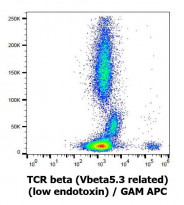ARG65496
anti-TCR beta (Vbeta5.3 related) antibody [MEM-262] (low endotoxin)
anti-TCR beta (Vbeta5.3 related) antibody [MEM-262] (low endotoxin) for Flow cytometry,Functional study,Immunoprecipitation,Western blot and Human
Overview
| Product Description | Azide free and low endotoxin Mouse Monoclonal antibody [MEM-262] recognizes TCR beta (Vbeta5.3 related) |
|---|---|
| Tested Reactivity | Hu |
| Tested Application | FACS, FuncSt, IP, WB |
| Specificity | The antibody MEM-262 recognizes an extracellular epitope on beta chains of the TCR expressed by HPB-ALL cell line [carrying V(beta5.3)] and a small subset of peripheral blood T cells. This subset is larger than that recognized by other V(beta5.3)-specific antibodies. |
| Host | Mouse |
| Clonality | Monoclonal |
| Clone | MEM-262 |
| Isotype | IgG2a |
| Target Name | TCR beta (Vbeta5.3 related) |
| Antigen Species | Human |
| Immunogen | Human thymoma cell line HPB-ALL. |
| Conjugation | Un-conjugated |
| Alternate Names | TCRB |
Application Instructions
| Application Suggestion |
|
||||||||||
|---|---|---|---|---|---|---|---|---|---|---|---|
| Application Note | * The dilutions indicate recommended starting dilutions and the optimal dilutions or concentrations should be determined by the scientist. |
Properties
| Form | Liquid |
|---|---|
| Purification | Purification with Protein A. |
| Purification Note | 0.2 µm filter sterilized. Endotoxin level is <0.01 EU/µg of the protein. |
| Buffer | PBS |
| Concentration | 1 mg/ml |
| Storage Instruction | For continuous use, store undiluted antibody at 2-8°C for up to a week. For long-term storage, aliquot and store at -20°C or below. Storage in frost free freezers is not recommended. Avoid repeated freeze/thaw cycles. Suggest spin the vial prior to opening. The antibody solution should be gently mixed before use. |
| Note | For laboratory research only, not for drug, diagnostic or other use. |
Bioinformation
| Database Links | |
|---|---|
| Gene Symbol | TRB |
| Gene Full Name | T cell receptor beta locus |
| Background | T cell receptors recognize foreign antigens which have been processed as small peptides and bound to major histocompatibility complex (MHC) molecules at the surface of antigen presenting cells (APC). Each T cell receptor is a dimer consisting of one alpha and one beta chain or one delta and one gamma chain. In a single cell, the T cell receptor loci are rearranged and expressed in the order delta, gamma, beta, and alpha. If both delta and gamma rearrangements produce functional chains, the cell expresses delta and gamma. If not, the cell proceeds to rearrange the beta and alpha loci. This region represents the germline organization of the T cell receptor beta locus. The beta locus includes V (variable), J (joining), diversity (D), and C (constant) segments. During T cell development, the beta chain is synthesized by a recombination event at the DNA level joining a D segment with a J segment; a V segment is then joined to the D-J gene. The C segment is later joined by splicing at the RNA level. Recombination of many different V segments with several J segments provides a wide range of antigen recognition. Additional diversity is attained by junctional diversity, resulting from the random additional of nucleotides by terminal deoxynucleotidyltransferase. Several V segments and one J segment of the beta locus are known to be incapable of encoding a protein and are considered pseudogenes. The beta locus also includes eight trypsinogen genes, three of which encode functional proteins and five of which are pseudogenes. Chromosomal abnormalities involving the T-cell receptor beta locus have been associated with T-cell lymphomas. [provided by RefSeq, Jul 2008] |
Images (1) Click the Picture to Zoom In






